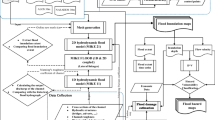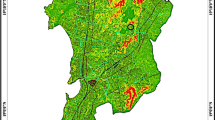Abstract
The main objective of this study is to improve the geoid by GPS/leveling data in Egypt. Comparisons of the gravimetric geoid with GPS/leveling data have been performed. On the basis of a gravimetric geoid fitted to GPS/leveling by the least square method, a smoothed geoid was obtained. A high-resolution geoid in Egypt was computed with a 2.5′×2.5′ grid by combining the data set of 2600 original point gravity values, 20″×30″ resolution Digital Terrain Model (DTM) grid and the spherical harmonic model EGM96. The method of computation involved the strict evaluation of the Stokes integral with 1D-FFT. The standard deviation of the difference between the gravimetric and the GPS/leveling geoid heights is ±0.47 m. The standard deviation after fitting of the gravimetric geoid to the GPS/leveling points is better than ±13 cm. In the future we will try to improve our geoid results in Egypt by increasing the density of gravimetric coverage.
Similar content being viewed by others
References
Abd-Elmotaal H. Gravity reduction techniques and their comparisons applied to the gravity field in Egypt. Second continental workshop on the geoid in Europe, Budapest, 1998. 177–183
El-Tokhey H. Geoid and best fitting reference ellipsoid by combination of heterogeneous data: [Ph. D thesis]. Ain Shans University and Graz University of Technology, 1993
Forsberg, R. Terrain effects in geoid computations. In:Proceedings of the International school for the Determination and use of the Geoid. Milan, 1994
Ghanem E, Li J C. Discussion on some FFT problems to determine the geoid.Journal of Wuhan Technical University of Surveying and Mapping, 2000,3(2):53–57
Ghanem E, Li J C, Liu J. A preliminary investigations for a new western china gravimetric geoid determination, EOS. Trans. Am. Geophy. Un. Supplement, 2000, 81
Haagmans R, De Min E, Van Gelderen M. Fast evaluation of convolution integrals on the sphere using 1D FFT, and a comparison with existing methods for Stokes'.Manuscripta Geodaetica, 1993;18:227–241
Harrison J C, Dickinson M. Fourier transform methods in local gravity modeling.Bull. Geod., 1998,63:447–455
Heiskanen W A, Moritz H. Physical Geodesy. San Francisco-London: Freeman & company, 1967
Lemoine F G. The development of the NASA GSFC and NIMA joint geopotential model Gravity, Geoid and Marine Geodesy, International Symposium No. 117, Tokyo. http://cddis.gsfc.nasa.gov/926/egm96/egm96.html, 1996
Li J, Ning J, Chao D. Comments on two dimensional convolutions of the geodetic problems in planar and spherical coordinates. The International Association of Geodesy Symposia, Brazil, 1997
Author information
Authors and Affiliations
Corresponding author
About this article
Cite this article
Ghanem, E. GPS-gravimetric geoid determination in Egypt. Geo-spat. Inf. Sci. 4, 19–23 (2001). https://doi.org/10.1007/BF02826631
Issue Date:
DOI: https://doi.org/10.1007/BF02826631




